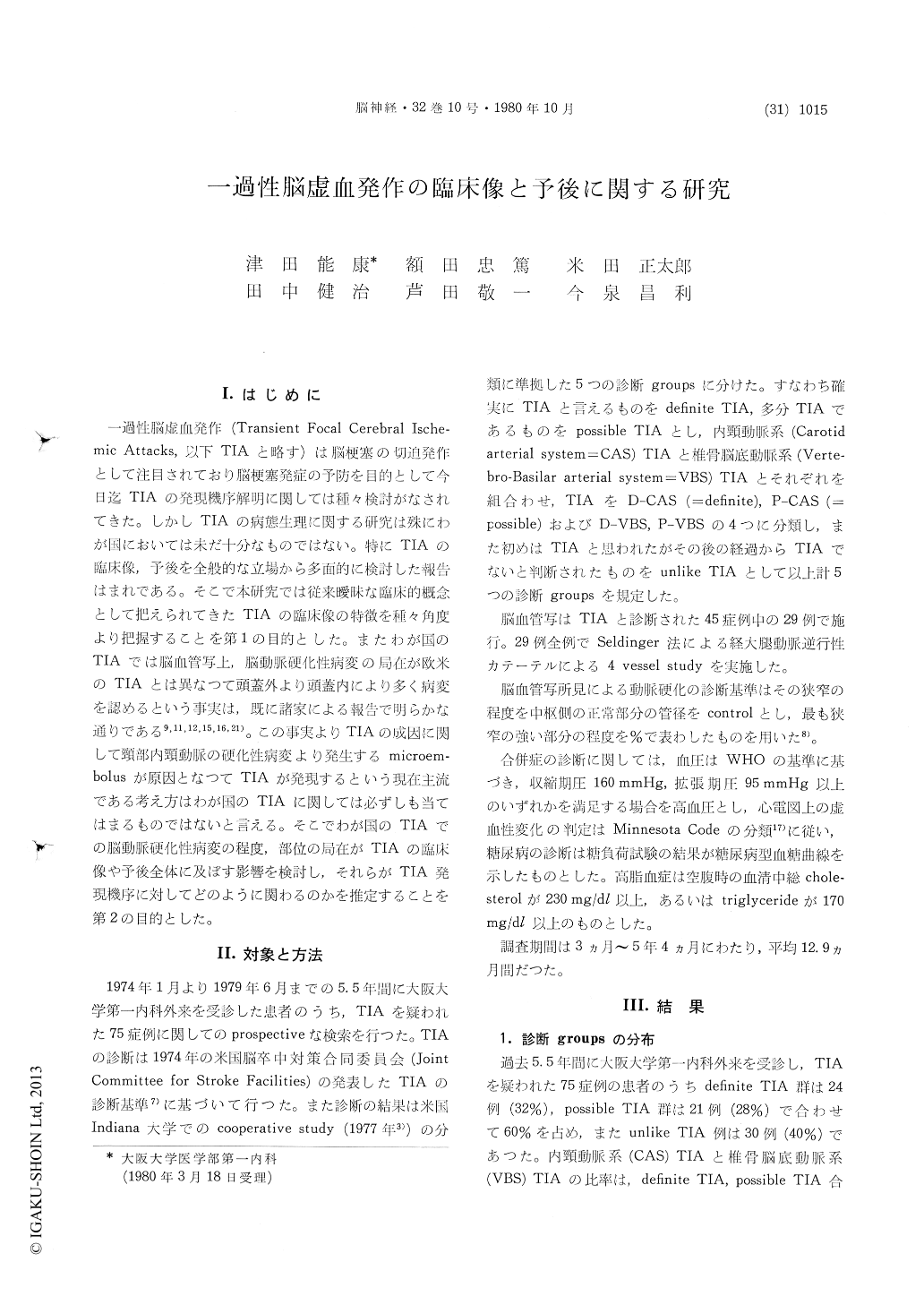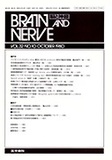Japanese
English
- 有料閲覧
- Abstract 文献概要
- 1ページ目 Look Inside
I.はじめに
一過性脳虚血発作(Transient Focal Cerebral Ische—mic Attacks,以下TIAと略す)は脳梗塞の切迫発作として注目されており脳梗塞発症の予防を目的として今日迄TIAの発現機序解明に関しては種々検討がなされてきた。しかしTIAの病態生理に関する研究は殊にわが国においては未だ十分なものではない。特にTIAの臨床像,予後を全般的な立場から多面的に検討した報告はまれである。そこで本研究では従来曖昧な臨床的概念として把えられてきたTIAの臨床像の特徴を種々角度より把握することを第1の目的とした。またわが国のTIAでは脳血管写上,脳動脈硬化性病変の局在が欧米のTIAとは異なつて頭蓋外より頭蓋内により多く病変を認めるという事実は,既に諸家による報告で明らかな通りである9,11,12,15,16,21)。この事実よりTIAの成因に関して頸部内頸動脈の硬化性病変より発生するmicroem—bolusが原因となつてTIAが発現するという現在主流である考え方はわが国のTIAに関しては必ずしも当てはまるものではないと言える。そこでわが国のTIAでの脳動脈硬化性病変の程度,部位の局在がTIAの臨床像や予後全体に及ぼす影響を検討し,それらがTIA発現機序に対してどのように関わるのかを推定することを第2の目的とした。
Seventy-five patients suspected Transient Cere-bral Ischemic Attacks (TIA) had been chosen for materials and examined prospectively during 5.5-year period, 1974 through 1979. The purposes of this study were to clarify the clinical features of TIAs at various viewpoints and to analyse thefactors relating with the prognosis of TIAs. TIA was diagnosed by clinical symptoms in accordance with the criteria for TIA of the Joint Committee for Stroke Facilities in the U.S.A.(1974). We defined 5 diagnostic categories in accordance with diagnostic grouping of the cooperative study of Indiana Univ., U.S.A.(1977), which were definite and possible carotid artery system TIA (D-CAS, P-CAS), definite and possible vertebro-basilar ar-tery system TIA (D-VBS, P-VBS), and remaining unlike TIA group (Unlike). The follow-up period had been for an average of 12.9 months.
The diagnostic groups distributed in 24 diagnosed definite TIA, and in 21 diagnosed possible TIA, while in remaining 30 diagnosed unlike TIA. In 45 pati-ents with definite and possible TIAs, 35 cases were thought to have carotid artery system TIAs, while 9 cases were thought to have vertebro-basilar ar-tery system TIAs, and 1 case was suggested in-volvement of both systems. The 45 patients with TIAs included 40 males and 5 females with an average age of 52.3 years old at the initial episode of TIA. As for the associated diseases with TIA, hyperlipemia (64%), hypertension (40%), ischemic heart changes on ECG (33%), and diabetes mellitus (29%) were the major 4 diseases. Arrhythmia, peripheral vascular diseases, valvular heart diseases were uncommon in our study.
Regarding to the frequency, 7 cases (16%) had only one episode in past, while 23 cases (51%) had the episodes of 2-4 times and 15 cases (33%) of more than 5 times. As for vertebro-basilar TIAs of 10 patients, no cases indicated only one episode in past.
The duration of TIA in 37 (83%) lasted less than 30 minutes including all of 10 cases of vertebro-basilar TIAs, and in 28 (63%) lasted less than 10 minutes in particular. On the contrary, 23% of carotid TIAs lasted 1-24 hours, considerably long duration.
Regarding to the angiographic findings, severe atherosclerotic lesions of more than 50% stenosis or occlusion were revealed in 20 cases (69%) of 29 patients who had taken caratid and vertebral angiographic examinations. Mild atherosclerotic lesions including less than 50% stenosis, wall ir-regularity, and normal arteriograms were observed in 9 cases (31%). The 4 cases of vertebro-basilar TIAs had the multiple atherosclerotic lesions in-volving carotid arterial stenotic or occlusive lesions. As regard to the locations of atherosclerosis, in 52% there existed only intracranial atherosclerotic lesions, in 18% there existed only extra-cranial atherosclerotic lesions. Cases involving both lesions were present in 30%.
As for the prognosis, 12 cases (27%) developed to complete strokes in our study during the follow-up period, which was relatively high incidence despite of the various treatments as compared with other TIA studies. The period of TIAs progress-ing to strokes had been within 12 months in all 12 cases. In vertebro-basilar TIAs, the incidence progressed to stroke was 10%, considerably lower than that in carotid TIAs. In patients with only one episode in past, the incidence progressed to stroke formed high percentage of 57%, like as asign of impending stroke.
Regarding to the prognosis with angiographic findings, cases with severe atherosclerotic lesions of more than 50% stenosis and occlusion or with intra-cranial atherosclerotic lesions formed high incidence of progressing to stroke when compared with cases with mild atherosclerotic lesions or with extra-cranial atherosclerotic lesions.

Copyright © 1980, Igaku-Shoin Ltd. All rights reserved.


